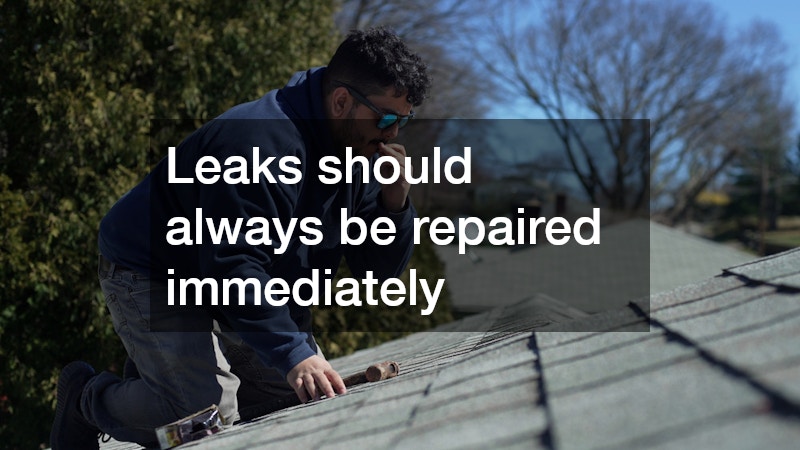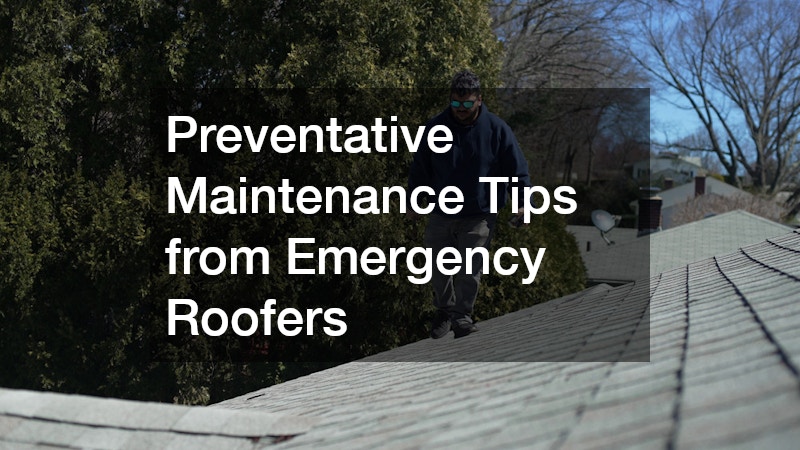Preventative Maintenance Tips from Emergency Roofers
-
Regular roof inspections, ideally twice a year, help detect small issues before they escalate into emergencies.
-
Routine maintenance tasks, such as gutter cleaning, debris removal, and trimming overhanging trees, reduce the risk of leaks and structural damage.
-
Minor repairs, like replacing loose shingles or sealing leaks, should be addressed promptly to avoid costly emergency roofing services.
-
Seasonal maintenance tailored to winter, spring, summer, and fall helps prevent weather-related damage.
-
Partnering with emergency roofers provides 24/7 access to professional repairs, expert advice, and preventative guidance.
-
Modern tools, such as drones and moisture meters, enhance maintenance efforts and help identify hidden problems.
-
Recognizing red flags—rapid leaks, sagging areas, or extensive mold—ensures timely intervention before severe damage occurs.
Your roof is one of the most important investments in your home, providing protection against the elements and safeguarding your family, possessions, and structural integrity. Despite its critical role, many homeowners neglect routine maintenance, only seeking help when leaks, storm damage, or other emergencies occur. At this point, contacting emergency roofers often becomes necessary, resulting in costly repairs and considerable stress.
Proactive maintenance, however, can dramatically reduce the likelihood of these situations. Emergency roofers see firsthand how minor issues left unchecked can escalate into urgent problems requiring immediate attention. By implementing preventative measures, homeowners can extend the lifespan of their roof, prevent structural damage, and maintain energy efficiency. This article covers comprehensive tips from emergency roofers, including inspections, routine maintenance, minor repairs, seasonal care, tools, and red flags that require immediate professional attention.
Understanding Roof Wear and Tear
Roofs are constantly exposed to weather, temperature fluctuations, and environmental hazards, making them susceptible to gradual wear and tear. Even the highest-quality materials deteriorate over time, and ignoring small issues often leads to emergency roofing situations.
Weather is one of the leading causes of roof damage. Heavy rain, hail, snow, and wind can dislodge shingles, crack tiles, or damage flashing. Prolonged exposure to sunlight and UV rays can cause shingles to dry out, crack, and become brittle. In addition, older roofs naturally experience material fatigue, including corrosion on metal roofs, cracked tiles, and weakened asphalt shingles. Poor installation practices can exacerbate these problems, leading to leaks, structural compromise, and water damage.
Emergency roofers frequently encounter homes where small issues like curling shingles, damaged flashing, or moss growth were ignored until they caused significant water infiltration or structural damage. Common warning signs include:
-
Missing, cracked, or curling shingles
-
Damaged flashing around chimneys, vents, and skylights
-
Water stains, mold, or mildew in attics or ceilings
-
Moss, algae, or lichen growth that traps moisture
-
Sagging areas or ponding water on flat roofs
Recognizing these signs early and taking preventative measures can reduce the need for urgent roofing services and help homeowners avoid costly repairs.
The Importance of Regular Roof Inspections
Routine inspections are one of the most effective ways to prevent emergency roofing issues. Even minor damage, if left unaddressed, can escalate quickly, leading to costly repairs and the need for immediate intervention from emergency roofers.
Emergency roofers recommend inspections at least twice a year—typically in the spring and fall—to identify damage caused by seasonal extremes. Additional inspections should be scheduled after major storms or when roofs are older than 15 years.
A thorough inspection should include:
-
Checking shingles for cracks, curling, blistering, or granule loss
-
Inspecting gutters and downspouts for blockages, rust, or improper drainage
-
Examining flashing around chimneys, vents, skylights, and roof edges for gaps or corrosion
-
Assessing attic moisture, water stains, mold, or mildew that may indicate hidden leaks
-
Inspecting roof decking for sagging, soft spots, or structural weaknesses
Professional inspections by emergency roofers can detect damage that is not visible from the ground. Additionally, inspectors can document roof conditions for insurance purposes, provide recommendations for timely repairs, and prevent minor issues from becoming emergencies. Regular inspections are essential for maintaining the integrity of your roof and minimizing the risk of urgent repairs.
Routine Maintenance Tasks for Homeowners
While professional inspections are critical, homeowners can perform several preventative maintenance tasks themselves. Routine upkeep reduces the likelihood of needing emergency roofing services and helps extend the life of your roof.
Key maintenance tasks include:
-
Gutter cleaning: Removing leaves, debris, and dirt prevents water backup and reduces the risk of leaks. Ensure downspouts direct water away from the foundation.
-
Debris removal from the roof: Branches, leaves, and moss trap moisture, which accelerates shingle deterioration and promotes leaks.
-
Trimming overhanging trees: Limiting branches reduces the chance of punctures or physical damage during storms.
-
Attic ventilation check: Proper airflow prevents condensation, mold growth, and roof deck deterioration. Inspect vents for blockages.
-
Edge and flashing inspection: Examine seals around chimneys, vents, and skylights; reapply caulking if necessary.
Additional considerations:
-
Avoid climbing on steep or high roofs without safety equipment.
-
Use telescopic cleaning tools or hire professionals for difficult-to-access areas.
-
Schedule annual professional inspections to complement DIY maintenance.
By combining regular inspections with these maintenance tasks, homeowners can prevent small issues from escalating into situations that require emergency roofers.
Proactive Repairs Before Problems Escalate
Even minor issues, if addressed promptly, can prevent emergencies that require urgent roofing services. Emergency roofers often report that many calls could have been avoided with timely, small repairs.
Common minor repairs to handle proactively:
-
Replace loose or missing shingles to prevent water infiltration.
-
Seal minor leaks around vents, skylights, or flashing.
-
Repair or replace damaged flashing to protect roof joints and edges.
-
Fix small areas of ponding water or clogged gutters to prevent rot.
Prioritization advice from emergency roofers:
-
Water penetration: Leaks should always be repaired immediately to prevent structural damage.
-
Structural vulnerabilities: Sagging areas, rotted decking, or compromised framing require urgent attention.
-
Material-specific issues: Asphalt shingles, metal roofing, and tile roofs each have unique repair needs that should be addressed with proper techniques.
Taking care of these repairs early reduces the risk of costly emergency roofing services and ensures the roof remains durable and weatherproof.

Seasonal Maintenance Tips
Different seasons pose distinct challenges for roofs. Following seasonal maintenance guidelines helps prevent damage and reduces the likelihood of emergency repairs.
Winter:
-
Remove snow and ice buildup to prevent ice dams and excessive structural weight.
-
Inspect shingles and flashing for freeze-thaw damage that could lead to leaks.
-
Keep gutters and downspouts clear for proper drainage of melting snow.
Spring:
-
Assess roofs for post-storm damage, including missing shingles or bent flashing.
-
Clear debris accumulated during winter storms.
-
Repair minor leaks discovered during the thaw.
Summer:
-
Inspect shingles for UV-related damage, cracking, or blistering.
-
Monitor for soft spots caused by heat expansion.
-
Schedule inspections to catch developing issues before they become emergencies.
Fall:
-
Clean gutters and roof surfaces from leaves and debris.
-
Inspect roof edges, flashing, and attic areas for moisture or mold.
-
Prepare for winter with proper insulation and ventilation checks.
Additional seasonal tips:
-
Install ice-melt systems or heat cables where ice dams are common.
-
Reapply caulking around vents and flashing after freeze-thaw cycles.
-
Schedule professional inspections during off-peak months to avoid delays in emergency roofing services.
By following these seasonal maintenance routines, homeowners can prevent many issues that would otherwise require urgent attention from emergency roofers.
Benefits of Partnering with Emergency Roofers
Even the most proactive homeowners benefit from having a reliable emergency roofer on call. Rapid access to professional services ensures that issues are addressed before they escalate into serious problems.
Advantages of working with emergency roofers:
-
Immediate response to leaks, storm damage, or structural issues
-
Expert inspections to identify hidden problems before they worsen
-
Advice on preventative products, materials, and repair techniques
-
Reduced insurance claims by mitigating extensive damage early
-
Peace of mind knowing professional help is available 24/7
Emergency roofers not only handle urgent repairs but also provide guidance to prevent future emergencies, making them a critical partner in proactive roof maintenance.
Tools and Technology for Effective Roof Maintenance
Modern tools have made roof inspections and maintenance safer and more effective. Emergency roofers rely on technology to quickly detect and address potential issues.
Key tools and technologies include:
-
Drones: High-resolution aerial imagery allows inspection of difficult-to-access areas.
-
Moisture meters: Detect water intrusion in attic spaces or under roofing materials.
-
Roofing apps and scheduling software: Track maintenance, repairs, and inspection history.
Practical applications for homeowners:
-
Document roof conditions to monitor deterioration over time.
-
Maintain a record of maintenance tasks and repairs for insurance or warranty claims.
-
Share digital inspection data with emergency roofers for faster, more accurate assessments.
Using these tools allows homeowners to identify issues before they become emergencies, reducing the need for urgent roofing services.
Red Flags That Require Immediate Professional Attention
Despite proactive maintenance, some issues require urgent intervention from emergency roofers. Recognizing these red flags can prevent extensive damage and costly repairs.
Signs that demand immediate professional attention:
-
Rapid water infiltration or active leaks
-
Sagging roof areas or structural instability
-
Large sections of missing or damaged shingles
-
Significant mold, rot, or mildew growth
-
Recurrent leaks despite minor repairs
Steps to take when red flags appear:
-
Contact emergency roofers immediately for assessment and repair
-
Document damage for insurance purposes
-
Avoid DIY repairs that could worsen structural issues
Prompt response from emergency roofing services prevents further damage and ensures the safety of your home.
Preventative maintenance is the most effective strategy to protect your home and reduce reliance on emergency roofers. Regular inspections, routine upkeep, timely repairs, seasonal care, and the use of modern tools all contribute to a roof that lasts longer and performs better.
Emergency roofers not only respond to urgent problems but also provide valuable insights to prevent future issues. Establishing a relationship with a trusted emergency roofing service, performing regular inspections, and addressing minor issues promptly ensures a safe, durable roof and peace of mind for years to come.

